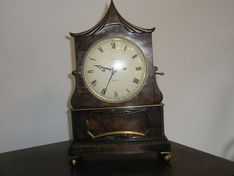How to set up a clock
It is not possible to cover every example of clock made over several hundred years but you will find most of the clocks you are likely to encounter. Select a clock type similar to your own and follow the basic principles.
Terms used should be understood easily, the following will help:
- Timepiece is a clock that tells the time only, without any additional functions.
- Striking clock sounds the hours by striking a bell or gong the number of times that corresponds to the hour indicated.
- Chiming is sounding each quarter hour.
- Regulating is adjusting the speed the clock runs.
- Suspension is a small spring or thread that either the pendulum hangs on or is attached to the top of the pendulum.
- Bob, is the lumpy part of the pendulum.
- Rating nut, is a screw turned to move the pendulum bob up or down.
- Crutch, is the part of the clock that moves with the pendulum.
- On-beat, is when the clock is ticking evenly.
- Platform escapement, clocks have a fast moving balance wheel on top or near the top, they have a rapid tick
It is important that strong screws hang wall clocks. Unlike a picture, clocks are wound, regulated, doors open, every week, which increases the risk of a screw giving way. The fixing should be a sturdy screw relative to the weight of the clock and put into the wall at a downward angle. If a clock is not too heavy a large masonry nail driven in at a downward angle will suffice.
Longcase clocks are best screwed to the wall for safety. Clocks that stand on feet must be firm, not rocking about.
When going away for longer than your clock will run, it is best to stop it. If the clock stops by itself damage to the escapement may result. Do not silence your clock by not winding the striking part as this is likely to damage your clock. Advice for silencing the clock should come from the shop where your clock was purchased or a qualified horologist, such as Jeff Rosson at City Clocks.
The method of adjusting the tick of the clock is often by bending the crutch. This should be done carefully and sensibly. Do not use as a lever against the escapement as it could easily damage the pivots or escapement. The best method is to place the first and second finger spaced apart behind the opposite side of the crutch arm and push in the middle with the thumb. A slight bend makes a lot of difference to the tick.
Regulation is on a trial and error basis. Most clocks can be made to keep time to a minute or so a week, over a period of time, Try a small adjustment first to see what result is achieved. Do not expect quartz accuracy from an antique clock as it is not only unfair usually unnecessary as well.
Adjusting for British Summer Time
Twice a year we have to change our clocks. An easy way to remember which way to move the time is; in the spring forward the time and the autumn (fall) move it back. Spring forward, fall back.
There are many hundreds of different types of mechanical clock. These notes advise about the most common types of clock. Please contact us at City Clocks for specific advice if you are unsure. Our free downloadable files, above, may also help.
If your clock only tells the time you have little to worry about. A timepiece or, time only, clock will almost always have only one hole where you wind it up. These clocks will not be harmed whichever way you turn the hands. It is important you move only the longer minute hand forward one hour in the spring and back one hour at the end of October.
A striking clock will most often have two winding holes and a quarter chime clock will have three winding holes. In the spring move the longer minute hand forward allowing the clock to strike the quarter and half-hours. If you feel strong resistance at any point back up the hand about two minutes and let the clock strike before moving forward again.
When the clocks go back in October you have to be much more careful if your clock strikes or chimes. French carriage clocks in particular are very easily damaged and repairs are expensive. In November we have quite a few damaged clocks for repair.
If your clock has a pendulum the safest way to turn the clock back is to stop your clock for one hour. If your clock is large open the door and grasp the pendulum to stop it. One hour later move the pendulum to one side and let go. If your clock is smaller just tilt the clock forward until the sticking stops then gently allow the clock to be upright again. One hour later tilt the clock to one side and back to upright. The clock will start ticking again.
If your clock has a balance wheel, as in a carriage clock you will have to move the hands gently forward eleven hours, allowing the clock to strike each hour, half hour and quarter hour if that is what it is supposed to do. This may seem tedious to some people but it is worth the time to avoid expensive damage to your clock.
This is also a good time to clean the glass and give the case a little polish.
City Clocks Maintenance
At City Clocks we will be happy to advise you on your clock maintenance.
Contact City Clocks here or call us on 0800 78 345 87.


